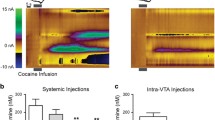Abstract
Previous studies have reported that antidepressant drugs exert specific effects on responding maintained by DRL schedules of reinforcement, giving rise to increased frequencies of reinforcement. In order to investigate whether the α2-adrenoceptor antagonist idazoxan would produce similar effects, the actions of this compound were compared with those of yohimbine, imipramine, mianserin and d-amphetamine in rats trained to lever press for food reinforcement on a DRL 60-s schedule. Neither imipramine nor mianserin produced any effects on response rate or reinforcement frequency, except at the highest doses. In contrast, both idazoxan and yohimbine gave rise to dose-related increases in rates of responding and consequent decreases in reinforcement frequencies. Amphetamine also increased responding, but higher doses of this drug produced marked hyperactivity and stereotyped movements which were not observed after idazoxan and yohimbine. Although the present behavioural baseline was not sensitive to antidepressants, it demonstrated an unexpected activity of two α2-adrenoceptor antagonists which deserves further investigation.
Similar content being viewed by others
References
Anden NE, Pauksens K, Svensson K (1982) Selective blockade of brain α2-autoreceptors by yohimbine: effects on motor activity and on turnover of noradrenaline and dopamine. J Neural Transm 55:111–120
Chopin P, Pellow S, File SE (1986) The effects of yohimbine on exploratory and locomotor behaviour are attributable to its effects at noradrenaline and not at benzodiazepine receptors. Neuropharmacology 25:53–57
Colpaert FC (1986) Effects of putative α-adrenoceptor antagonists and of other compounds on the loss of righting reflex and on exophthalmia induced by xylazine in the rat. Drug Dev Res 7:125–140
Colpaert FC, Janssen PAF (1985) Discriminative stimulus properties of xylazine in rat: discriminability and effects of putative alpha-2 adrenoceptor agonists and antagonists. J Pharmacol Exp Ther 235:521–527
Crossley DI (1984) The effects of idazoxan, an α2-adrenoceptor antagonist, in depression — a preliminary investigation. Proc 9th Int Congr Pharmacol Abstr 1724P
Dennis T, L'Heureux R, Carter C, Scatton B (1987) Presynaptic alpha-2 adrenoceptors play a major role in the effects of idazoxan on cortical noradrenaline release (as measured by in vivo dialysis) in the rat. J Pharmacol Exp Ther 241:642–650
De Sarro GB, Ascioti C, Froio F, Libri V, Nistico G (1987) Evidence that locus coeruleus is the site where clonidine and drugs acting at α1-and α2-adrenoceptors affect sleep and arousal mechanisms. Br J Pharmacol 90:675–685
Dettmar PW, Lynn AG, Tulloch IF (1983) Neuropharmacological studies in rodents on the action of RX 781094, a new selective α2-adrenoceptor antagonist. Neuropharmacology 6:729–737
Doxey JC, Roach AG, Smith CFC (1983) Studies on RX 781094: a selective, potent and specific antagonist of α2-adrenoceptors. Br J Pharmacol 78:489–505
File SE (1987) The contribution of behavioural studies to the neuropharmacology of anxiety. Neuropharmacology 26:877–886
Handley SL, Mithani S (1984) Effects of alpha-adrenoceptor agonists and antagonists in a maze-exploration model of “fear”-motivated behaviour. Naunyn-Schmiedeberg's Arch Pharmacol 327:1–5
Howard JL, Pollard GT (1984) Effects of imipramine, bupropion, chlorpromazine, and clozapine on differential-reinforcement-of-low-rate (DRL) τ 72-s and τ 36-s schedules in the rat. Drug Dev Res 4:607–616
Huang M, Messing RB, Sparber SB (1987) Learning enhancement and behavioral arousal induced by yohimbine. Life Sci 41:1083–1088
Lamb RJ, McMillan DE (1986) The effects of some putative antidepressant agents on the schedule-controlled behavior of the pigeon. Psychopharmacology 88:368–373
Langer SZ (1978) Presynaptic receptors. Nature 275:479–480
Langer SZ (1980) Presynaptic regulation of the release of catecholamines. Pharmacol Rev 32:337–362
Leander JD, Carter RB (1984) Effects of norepinephrine and serotonin uptake inhibitors on the schedule controlled behavior of the pigeon. Pharmacol Biochem Behav 20:391–395
McGuire PS, Seiden LS (1980) The effects of tricyclic antidepressants on performance under a differential-reinforcement-of-low-rates schedule in rats. J Pharmacol Exp Ther 214:635–641
McKearney JW, Barrett JE (1978) Schedule-controlled behavior and the effects of drugs. In: Blackman DE, Sanger DJ (eds) Contemporary research in behavioral pharmacology. Plenum Press, New York
O'Donnell JM (1987) Effects of clenbuterol and prenalterol on performance during differential reinforcement of low response rate in the rat. J Pharmacol Exp Ther 241:68–75
O'Donnell JM, Seiden LS (1982) Effects of monoamine oxidase inhibitors on performance during differential reinforcement of low response rate. Psychopharmacology 78:214–218
O'Donnell JM, Seiden LS (1983) Differential-reinforcement-of-low-rate 72-sec schedule: Selective effects of antidepressant drugs. J Pharmacol Exp Ther 224:80–88
Pellow S, Chopin P, File SE (1985) Are the anxiogenic effects of yohimbine mediated by its action at benzodiazepine receptors? Neurosci Lett 55:5–9
Pinder RM (1985) α2-Adrenoceptor antagonists as antidepressants. Drugs of the Future 10:841–857
Pollard GT, Howard JL (1986) Similar effects of antidepressant and non-antidepressant drugs on behavior under an interresponse-time τ 72-s schedule. Psychopharmacology 89:253–258
Rastogi SK, McMillan DE (1985) Effects of some typical and atypical antidepressants on schedule-controlled responding in rats. Drug Dev Res 5:243–250
Sanger DJ (1987) Effects of drugs on schedule-controlled behavior. In: Greenshaw AJ, Dourish CT (eds) Experimental psychopharmacology. Humana, Clifton, New Jersey
Seiden LS, O'Donnell JM (1985) Effects of antidepressant drugs on DRL behavior. In: Seiden LS, Balster RL (eds) Behavioral pharmacology: the current status. Liss, New York
Seiden LS, Dahms JL, Shaughnessy RA (1985) Behavioural screen for antidepressants: the effects of drugs and electroconvulsive shock on performance under a differential-reinforcement-of-low-rate schedule. Psychopharmacology 86:55–60
Sethy VH, Winter JC (1972) Effects of yohimbine and mescaline on punished behavior in the rat. Psychopharmacology 23:160–166
Sugrue MF (1981) Current concepts on the mechanism of action of antidepressant drugs. Pharmacol Ther 13:219–247
Sulser F (1983) Mode of action of antidepressant drugs. J Clin Psychiatry 44:14–20
Author information
Authors and Affiliations
Rights and permissions
About this article
Cite this article
Sanger, D.J. The α2-adrenoceptor antagonists idazoxan and yohimbine increase rates of DRL responding in rats. Psychopharmacology 95, 413–417 (1988). https://doi.org/10.1007/BF00181958
Received:
Revised:
Issue Date:
DOI: https://doi.org/10.1007/BF00181958



